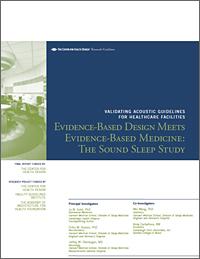Evidence-Based Design Meets Evidence-Based Medicine: The Sound Sleep Study

National healthcare quality surveys have found that noise in hospitals is an urgent concern. The purpose of this study was to demonstrate the impact of hospital noise on all stages of human sleep by developing sleep arousal probability threshold curves for specific hospital-based sounds. Most hospital sound sources were recorded on-site corresponding to specific categories identified in the American Institute of Architects' Draft Interim Guideline on Sound and Vibration in Healthcare Facilities. Fourteen sounds were chosen and calibrated for dynamic presentation. They were transmitted through an array of speakers positioned in a hospital sleep laboratory room. Sounds were delivered in rising 5 decibel-step exposures from 40 to 70 dB(A), with steady 32 dB(A) night background levels from air-handling equipment.
Noise-related sleep arousals were recorded and quantified using current American Association of Sleep Medicine EEG criteria. These arousals were summed for each sleep stage by sound type at each decibel step level and then plotted as arousal probability thresholds. The results provide evidence that repeated arousals occur from common hospital noises at typical decibel levels even in healthy young adults. The reported responses varied with the sound stimulus characteristics and across different sleep stages.


Add comment
Log in to post comments